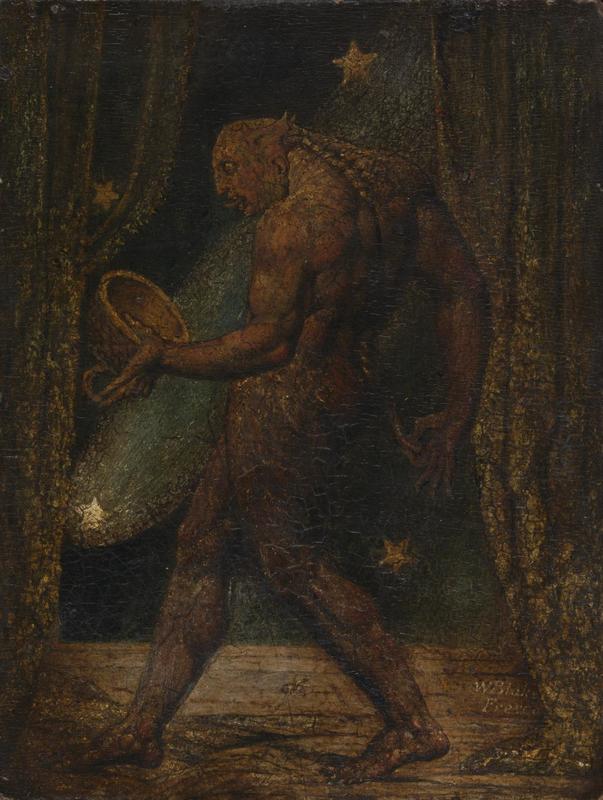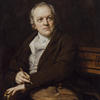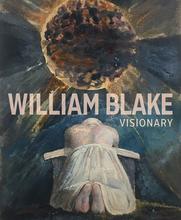More about The Ghost of a Flea
- All
- Info
- Shop

Contributor
The Ghost of a Flea is the result of William Blake staying up just a little too long past his bedtime.
Romantic poet and artist William Blake is known primarily for his illuminated books, in which he interwove his poetry and his pictures into one seamless whole, as well as his paintings based on stories from the Bible and other existing works of literature. The Ghost of a Flea is unique for being one of the few standalone paintings he made during his lifetime. After many years of obscurity and disappointment, Blake eventually fell in with a group of younger artists who admired his unique artistic vision, providing him with the patronage and friendship he’d always desired but tragically hadn’t been able to find until the final decade of his life. Among this new circle of friends was the watercolorist and astrologer John Varley, a famously gullible man with a passion for all things supernatural, strange, or in any way contrary to the rational. He was, naturally, enchanted with the eccentric Blake.
One night in 1819, Blake stayed up late with Varley sketching this portrait of a humanoid flea. Believe it or not, this wasn’t at all an unusual way for the two men to spend an evening together—they would often hold late-night séances at Varley’s place, staying up as late as four in the morning (a couple of party animals, those two) and having a grand old time calling on the spirits of various historical and Biblical figures, whom Blake would then proceed to draw for Varley’s amusement. This particular spirit of a flea-man visited Blake on one of these wild nights, relaying the message that there was more to fleas than met the eye. According to the spirit, they were inhabited by the souls of men who, while alive, had been “by nature bloodthirsty to excess.” As punishment, such men were apparently reincarnated in the bodies of fleas, condemned to have their “bloodthirsty” natures literalized for all eternity.
These nocturnal tête-à-têtes with Varley were far from being the only time Blake experienced such visions. He reportedly saw God for the first time at the tender age of four, when God stuck his head through a window and set him “ascreaming” in fear. Another anecdote relates the ten-year-old Blake walking down a London street minding his own business, only to glance up and see a treeful of angels spread above him, gleaming as bright as stars. Varley, obsessed as he was with mystical experiences, both admired Blake for his visionary capacities and felt just a teensy bit jealous of him. Having heard all the stories about Blake seeing God and angels, he started inviting him round his place in hopes that he might pick up a tip or two on how to have some super cool visions of his own. But—surprise surprise—his plan didn’t work; strain as he might, he found himself staring at nothing but empty space, night after night.
Whether Blake himself actually saw these figures sitting solidly before him is unclear. They may have been hallucinations (many of his contemporaries did think he was insane), or products of his vivid imagination, or fanciful inventions done for the benefit of the young and credulous Varley, who so desperately wanted them to be real. Or they may have actually been there. Who knows? Blake himself maintained that they were true-to-life portraits of spirits, as did Varley in his 1828 book A Treatise on Zodiacal Physiognomy, which featured copies of Blake’s drawings from these meetings. The drawings themselves fill several sketchbooks, and are known collectively as his Visionary Heads, many of which can be found today at the Tate Britain. By far the most famous (and creepy) of these is The Ghost of Flea, the only one Blake ever converted into a painting.
Never one to miss an opportunity to paint a super jacked male nude, Blake’s flea’s muscular build gives it a powerful, commanding presence on what appears to be a stage. All together, the backdrop of children’s picture-book stars, the little acorn-cap cup (like something a fairy might carry), and the general impression the flea gives of being on the verge of performing either a magic trick or a musical number, transforms the flea—generally thought of as a distasteful yet fairly insignificant nuisance—into something both fantastical and astonishing. Thus, a creature usually ignored and kept out of sight is brought literally front and center in Blake’s painting, depicted as the whimsical star of some kind of bizarre, one-man show. Blake’s flea rests somewhere on the spectrum between the terrifying and the marvelous, but where doesn’t really matter—the point is that Blake imbues the flea with its very own stage presence and dignity.
Some have speculated that the painting was inspired by Blake seeing a set of drawings of fleas under a microscope done by the 17th-century English natural philosopher Robert Hooke. Under the microscope’s unforgiving eye, the flea (once nothing more than a tiny black speck) was transformed into something at once banal and horrifying, its anatomy laid bare on the page and leaving no room for mystery. Blake, like many of his fellow Romantics, felt anxious that the far-probing eye of science might be destroying the human capacity for wonder. Images like those of Hooke’s fleas symbolized a gradual disenchantment of the world since the Scientific Revolution, a result of sense-extending technologies like microscopes and telescopes which left little to the imagination. In this context, The Ghost of a Flea can be interpreted as Blake’s attempt to re-enchant the insect world, from something thoroughly diagrammed by science into a realm at once wonderful and strange.
Sources
- Artandfilm21. “William Blake. The Flea. The Art of Gothic Documentary clip.” Youtube video, 2:52. January 13, 2016. https://www.youtube.com/watch?v=HdCssK0uGUc.
- Bentley, G.E., Jr. William Blake: The Critical Heritage. New York: Routledge, 1975.
- Butlin, Martin. “Blake, Linnell and Varley and A Treatise on Zodiacal Physiognomy.” In Burning Bright: Essays in Honour of David Bindman, edited by Diana Dethloff, Tessa Murdoch, and Kim Sloan, 126-135. London: UCL Press, 2015.
- “Exhibition Guide: William Blake.” Tate. Accessed June 17, 2020. https://www.tate.org.uk/ whats-on/tate-britain/exhibition/william-blake/exhibition-guide.
- “The Ghost of a Flea.” Atlas Obscura. Accessed June 18, 2020. https://www.atlasobscura.com/ places/the-ghost-of-a-flea.
- Gilchrist, Alexander. The Life of William Blake. London: John Lane Company, 1907.
- “The Head of the Ghost of a Flea. Verso: A Profile and a Reduced Drawing of Milton’s First Wife.” Tate. Accessed June 3, 2020. https://www.tate.org.uk/art/artworks/blake-the- head-of-the-ghost-of-a-flea-verso-a-profile-and-a-reduced-drawing-of-miltons
- Symons, Arthur. William Blake. London: Archibald Constable and Company Ltd., 1907.
Featured Content
Here is what Wikipedia says about The Ghost of a Flea

The Ghost of a Flea is a miniature painting by the English poet, painter and printmaker William Blake, held in the Tate Gallery, London. Measuring only 8.42 by 6.3 inches (21.4 by 16.0 centimetres), it is executed in a tempera mixture with gold, on a mahogany-type tropical hardwood panel. It was completed between 1819 and 1820, as part of a series depicting "Visionary Heads" commissioned by the watercolourist and astrologist John Varley (1778–1842). Fantastic, spiritual art was popular in Britain from around 1770 to 1830, and during this time Blake often worked on unearthly, supernatural panels to amuse and amaze his friends.
At 21.4 cm × 16.2 cm the work is a greatly reduced miniature portrait. Blake generally worked on a small scale; most of his illuminated pages, engravings and many of his paintings are only inches high. Although Ghost of a Flea is one of Blake's smallest works, it is monumental in its imagination. Its tiny scale achieves drama in contrasting the muscular bulk and apparent power of the creature against its incarnation in the panel as an insect.
Check out the full Wikipedia article about The Ghost of a Flea













